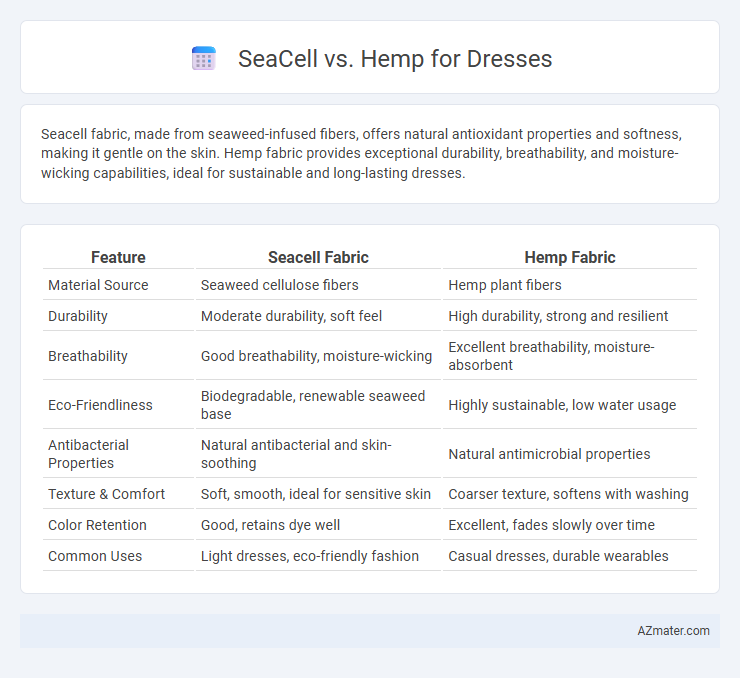Seacell fabric, made from seaweed-infused fibers, offers natural antioxidant properties and softness, making it gentle on the skin. Hemp fabric provides exceptional durability, breathability, and moisture-wicking capabilities, ideal for sustainable and long-lasting dresses.
Table of Comparison
| Feature | Seacell Fabric | Hemp Fabric |
|---|---|---|
| Material Source | Seaweed cellulose fibers | Hemp plant fibers |
| Durability | Moderate durability, soft feel | High durability, strong and resilient |
| Breathability | Good breathability, moisture-wicking | Excellent breathability, moisture-absorbent |
| Eco-Friendliness | Biodegradable, renewable seaweed base | Highly sustainable, low water usage |
| Antibacterial Properties | Natural antibacterial and skin-soothing | Natural antimicrobial properties |
| Texture & Comfort | Soft, smooth, ideal for sensitive skin | Coarser texture, softens with washing |
| Color Retention | Good, retains dye well | Excellent, fades slowly over time |
| Common Uses | Light dresses, eco-friendly fashion | Casual dresses, durable wearables |
Introduction to Seacell and Hemp Fabrics
Seacell fabric is a bio-fiber made from cellulose and seaweed, offering natural anti-bacterial and skin-soothing properties, making it ideal for eco-friendly dresses. Hemp fabric, derived from the durable hemp plant, provides breathability, moisture-wicking, and exceptional strength, suitable for sustainable and long-lasting clothing. Both materials emphasize environmental benefits, with Seacell promoting skin health and Hemp ensuring robust textile performance.
Origins and Production Processes
Seacell fabric originates from a blend of seaweed fibers and sustainable cellulose, harvested from marine algae and combined with wood pulp through eco-friendly, solvent-free processing, offering natural minerals beneficial for skin. Hemp fabric is derived from the bast fibers of the Cannabis sativa plant, cultivated with low environmental impact through minimal water use and pesticides, and processed using mechanical retting or chemical methods to extract durable, breathable fibers. Both materials emphasize sustainability, with Seacell harnessing ocean resources and Hemp relying on robust, fast-growing terrestrial plants.
Environmental Impact: Sustainability Comparison
Seacell fabric, derived from seaweed and wood pulp, offers a sustainable alternative by promoting biodegradability and requiring less water in production compared to conventional textiles. Hemp fabric excels in environmental sustainability with rapid growth, low pesticide use, and high carbon sequestration, making it a highly eco-friendly choice for dress materials. Both fabrics reduce environmental impact significantly, but hemp's durability and minimal resource demands position it as a leading sustainable option.
Fabric Texture and Comfort
Seacell fabric, derived from seaweed and cellulose fibers, offers a soft, smooth texture with moisture-wicking properties, enhancing breathability and comfort for dresswear. Hemp fabric is coarser but becomes softer with washing, providing durability and natural antibacterial qualities, making it ideal for eco-friendly, breathable dresses. Both materials ensure comfort, with Seacell excelling in silk-like softness and Hemp offering a rustic, sturdy feel.
Breathability and Moisture Management
Seacell fabric offers excellent moisture management by incorporating seaweed fibers that naturally regulate humidity and provide antibacterial properties, enhancing breathability for comfortable wear. Hemp fabric is highly breathable due to its porous fiber structure, allowing steady airflow and effective moisture wicking that keeps the skin dry and cool. Comparing both, Seacell excels in moisture absorption with added skin benefits, while hemp provides superior ventilation and durability for dress materials.
Durability and Longevity
Seacell fabric blends seaweed fibers with cellulose, offering moderate durability but may wear faster with frequent washing due to its delicate structure. Hemp fabric stands out for exceptional durability and longevity, boasting natural resistance to abrasion and UV exposure, ensuring dresses maintain shape and strength over years. Choosing hemp results in longer-lasting garments that withstand regular use and washing better compared to Seacell blends.
Skin Health and Hypoallergenic Properties
Seacell fabric, infused with seaweed nutrients, promotes skin health by releasing antioxidants and vitamins that can soothe irritation and improve moisture retention. Hemp fabric is naturally hypoallergenic, breathable, and antimicrobial, reducing the risk of skin allergies and infections. Both materials support skin health, but Seacell offers enhanced bioactive benefits while hemp excels in durability and allergen resistance.
Dyeing and Color Retention
Seacell fabric, infused with seaweed fibers, exhibits superior dye absorption and vibrant color retention due to its natural cellulose structure, which binds dyes effectively. Hemp fabric, known for its durability and breathability, often requires pre-treatment for optimal dye uptake, but once dyed, it maintains color well with excellent resistance to fading under UV exposure. Both materials offer eco-friendly dyeing profiles, yet Seacell consistently delivers richer hues and longer-lasting color vibrancy in dress applications.
Cost and Market Availability
Seacell fabric, derived from seaweed and cellulose fibers, tends to have a higher production cost compared to hemp due to its specialized manufacturing process, making Seacell dresses generally more expensive. Hemp fabric is widely available and cost-effective, benefiting from established cultivation and processing methods that drive its competitive pricing in the dress market. Market availability favors hemp dresses with a broader distribution and variety, while Seacell remains niche, often found in premium or eco-conscious clothing lines.
Best Choice: Seacell or Hemp for Dresses
Seacell fabric, derived from seaweed and cellulose fibers, offers exceptional moisture-wicking and skin-soothing properties, making it ideal for comfortable, breathable dresses. Hemp fabric stands out for its durability, natural antibacterial qualities, and eco-friendly cultivation, providing a sustainable option with a slightly textured feel. For dresses prioritizing softness and skin benefits, Seacell is the best choice, while Hemp excels in longevity and environmental impact.

Infographic: Seacell vs Hemp for Dress
 azmater.com
azmater.com